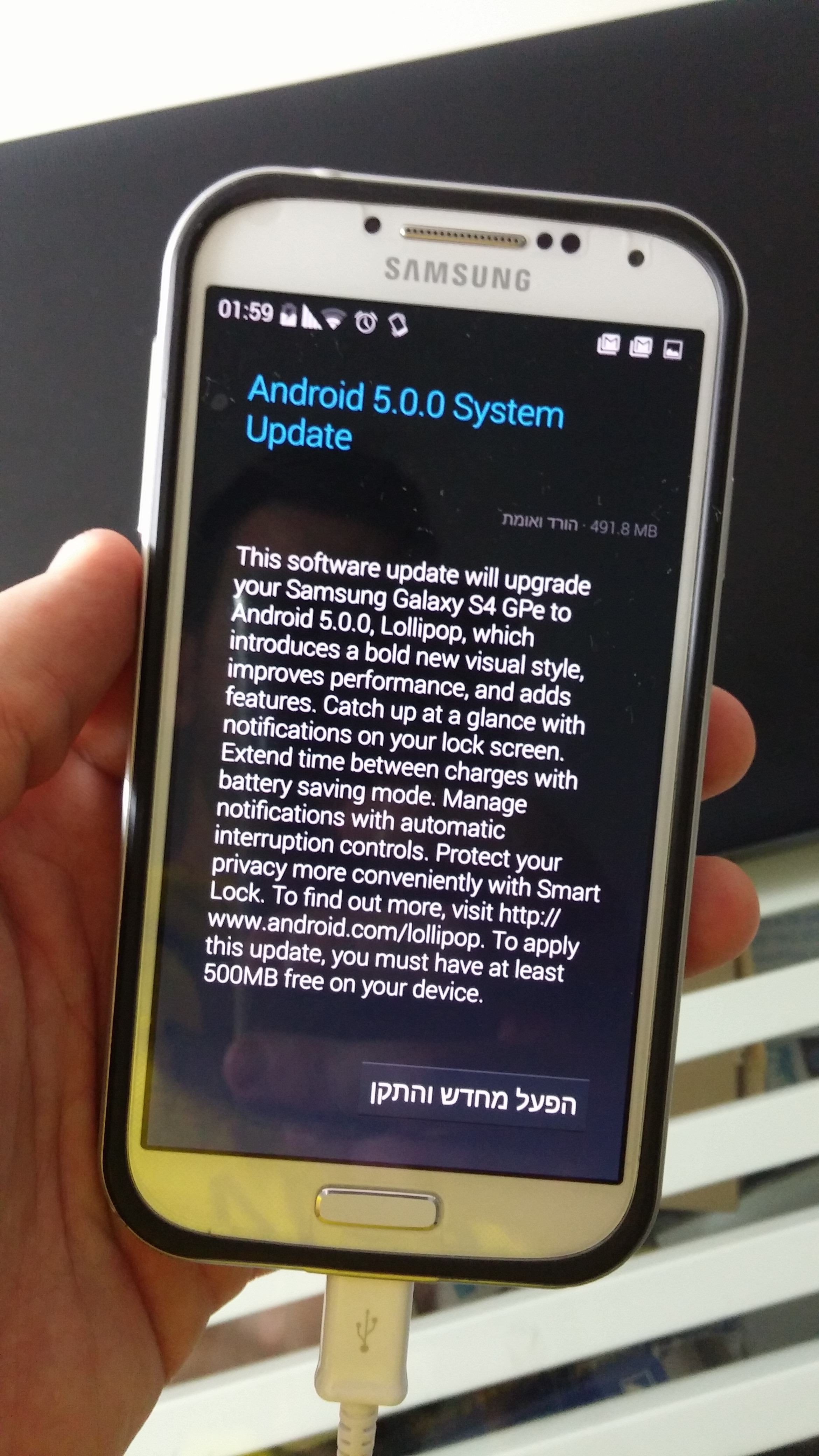
It’s Monday, which means a lot of you are going to be slacking off at work, so I thought I’d help you pass the time by sharing everything I know about Samsung’s latest flagship phone after spending a significant chunk of my weekend reading about it.
The Hardware
Let’s start with the specs. The device measures 136.6 mm x 69.8 mm x 7.9 mm. Now to put that into some context, the Galaxy S III is not only the same height, but it’s also 0.8 mm wider. That’s pretty incredible when you consider that the screen in the GS4 is 0.2 inches larger than the screen in the GS3.
As for weight, the GS4 comes in at 130 grams, making it 3 grams lighter than its predecessor.
With the GS4 having a smaller footprint than the GS3 and weighing slightly less, you would think that the battery would be negatively impacted, right? Wrong. While the GS3 had a 2,100 mAh battery, the GS4 has a whopping 2,600 mAh battery inside. It’s removable too!
You really have to stop and appreciate this type of engineering talent, plastic body aside.
Moving on to the guts, it makes sense to bring up the display first since that’s the component you’re going to spend most of your time interacting with. It’s a 5 inch 1080p AMOLED panel that uses a new subpixel arrangement that isn’t exactly PenTile, but it’s not RGB either. Last week I shared a video from Mobiwatch that demoed the new pixel layout. It’s personally hard for me to say whether or not it’s good since I haven’t seen the GS4, but from what I’ve read, people sound impressed, especially with the viewing angles.
Now let’s talk about the processor; technically, processors. If you live in America, your GS4 is going to come with Qualcomm’s Snapdragon 600 clocked at 1.9 GHz. What exactly is a Snapdragon 600? Think of it like an upgraded S4 Pro. The Snapdragon 600 is the same chip inside HTC’s One, albeit HTC opted to clock it at 1.7 GHz in order to improve battery life.
If you’re somewhere that isn’t the United State of America, then you’re going to get Samsung’s Exynos 5 Octa clocked at 1.6 GHz. As the name suggests, it’s an eight core processor. Don’t be fooled though, not all eight cores will be operational at the same time. The best way to think about the Octa is like a hybrid car. When you’re doing simple tasks like driving to the grocery store, or in this case checking your email, the GS4 will use four ARM Cortex A7 cores.
When you want to do something more intensive however, that’s when the gas engine kicks in. And for the Octa, that gas engine translates to four ARM Cortex A15 cores. I’m obviously going to have to wait until retail devices start shipping before saying the Octa is awesome, but on paper it should be.
How will those eight cores impact battery life is another question altogether.
While I’m on the topic of the processors, note that the Snapdragon 600 uses an Adreno 320, whereas the Exynos 5 Octa will be paired up with an Imagination Technologies PowerVR SGX 544.
Translation: The GS4 with the Samsung chip will have a faster GPU.
Now speedy chips need speedy memory, right? Samsung’s GS4 will come with 2 GB of LPDDR3 RAM. That’s faster than the LPDDR2 RAM inside the GS3 and HTC One, but how much faster remains to be seen. At least LPDDR3 uses less power, which is always a plus.
With regards to storage, there will be 16 GB, 32 GB, and 64 GB variants of the GS4 available, and all of them will have a microSD card slot that will allow you to shove in up to 64 GB of extra space.
And then there’s the camera. I’m not going to lie, I don’t know anything about it other than the fact that it’s a 13 megapixel part. Is it a Sony part? Is it a Samsung part? What kind of lens is attached?
No idea. Sorry.
Finally there’s the wireless bit. There’s quadband GSM/EDGE, as you’d expect. There’s quadband (850/900/1900/2100 MHz) HSPA+ 42 Mbps support. And there’s hexband 4G LTE support, but the exact bands weren’t specified. Oh and for the nerds out there, the 4G LTE is CAT3, meaning it maxes out at 100 Mbps. 802.11 AC is also inside, along with Bluetooth 4.0, GPS, and even GLONASS.
The Software
Here’s where the GS4 gets really interesting. It’s one of the first Android phones that’ll ship with Android 4.2.2, unlike HTC’s One, which ships with Android 4.1. Is having the latest version of Android important? Depends on the type of person you are. I’m fine being behind, but I know some of you are livid that you’re not using Google’s latest OS.
I’d like to remind you that Google I/O is taking place in May. Assuming they announce a new version of Android there, that means your month old GS4 will instantly be out of date.
But enough about Android, let’s run through all the things Samsung has done to the operating system and to the GS4 as a whole.
The phone has something called “Air View”. Instead of tapping the touch screen, you can just hover your finger slightly above it and expect something to happen. This exists on my Note II, but I have to use a stylus. Samsung wasn’t even the first company to have the “Air View” feature, that honor goes to Sony and their year old Xperia Sola.
There’s also “Air Gesture”. Say you’re eating something and your hands are dirty. You don’t want to touch your phone, right? With “Air Gesture”, you just wave your hand in front of your phone to swipe left and right through photos.
While I’m on the subject of features that don’t require you touching the device, there’s “Smart Pause” and “Smart Scroll”. The former is simple to understand. If you’re watching a movie, and you look away, the phone will pause your video. Look at your phone again, and the phone will resume the video. Brilliant, but it might drive you mad if you’re in a moving car, bus, train, what have you.
“Smart Scroll” on the other hand is a bit more perplexing. It doesn’t use eye tracking. Instead, it requires that you tilt the phone up or down to scroll through paragraphs. You can already play with this if you have Chrome installed. Open a bunch of tabs and see what happens when you move your phone around. The tabs move in the same direction.
Moving right along, there’s “Group Play”, which allows you to share audio with as many as seven friends. Remember being a kid and getting a bunch of radios tuned to the same radio station to make one giant sound system? “Group Play” is that, but using NFC and what I’m assuming is WiFi Direct.
“Samsung Adapt Display and Adapt Sound” will tweak what you’re looking at and listening to in order to give you a “better experience”. HTC does with with audio and calls it Beats. Sony does this with photos and video and calls it the Bravia Engine. Silly marketing terms all around, but hey, if it works, then it works. If not, just tick a box and the feature is off.
“Samsung WatchOn” is an infrared blaster so your phone can talk to your television. I wouldn’t know how to use it since I don’t have a cable box, but I’m sure lots of you will find it handy.
“Samsung Optical Reader” will scan your business cards and put the respective fields into a new contact card. Again, nothing new, but Samsung just loves to stick their branding in there!
“S Translator” is “Google Translate”, except it has some offline caching abilities.
“S Health” is an app that will hopefully start convincing you that you need to walk more instead of sitting in front of a computer all day. Expect to see a comprehensive demo of it once the phone starts shipping. The app will use the GS4’s bundled thermometer and barometer sensors, though how exactly isn’t yet known.
And finally, there’s the camera. In short, the camera user interface from the Galaxy Camera is coming to the GS4, meaning you’ll be able to switch between modes with a flip of your thumb. There are modes for removing moving objects in the background, there’s a mode that will record video using both the rear and the front facing camera, and there’s a mode that will attach a short audio clip to a still image. If that last feature sounds useless to you, it’s probably because it is.
Pricing and Availability
The GS4 will launch in three countries in late April, and then it’ll be out in 155 countries by the end of May. Which countries will be the first three? The UK is confirmed to be one of them, and I’m going to assume South Korea and Germany are the other two.
If you’re in America, wait for your respective operator to make an announcement. All the major operators will stock the GS4, so you’re good to go if you want to go the contract route.
As for price, it’s going to be an expensive phone. In Europe, it’ll likely run around 700 EUR unlocked. That’s roughly $900. You shouldn’t be surprised by this.
Concluding Thoughts
If you’re tired of reading about the GS4, I’m sorry to say this, but the future is only going to get worse. When the phone starts shipping, expect everyone and their mother to write a review, upload a video to YouTube, and record a one hour podcast telling people their thoughts.
I’ll try to find the best content out there, but I’m likely going to miss a lot since there will just be so much stuff to sift through. For now, here’s Samsung’s official GS4 product video:
http://youtu.be/2LHv1FPd1Ec
[Image Credit: Digital Trends]






